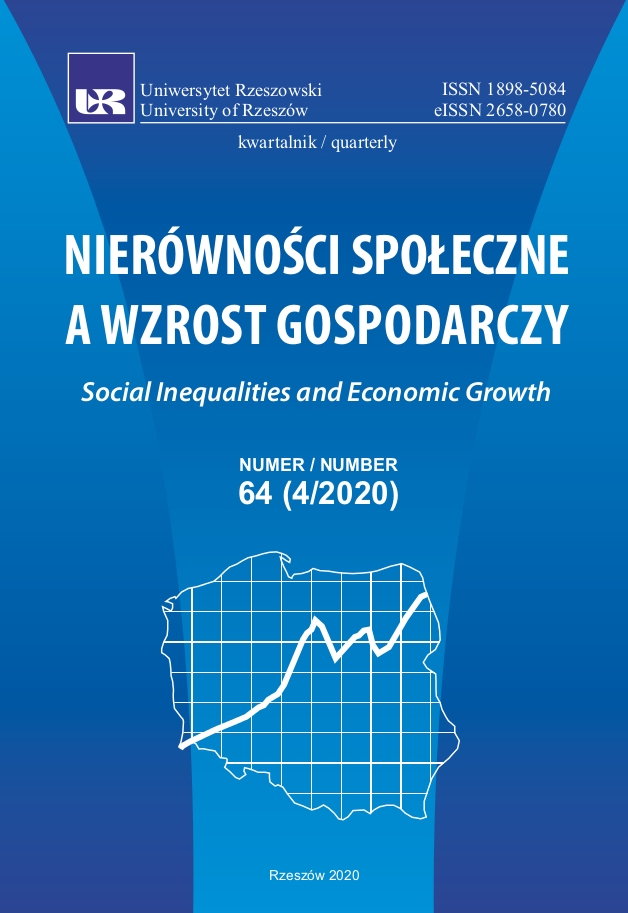Finansowe aspekty rozwoju zintegrowanego publicznego systemu ubezpieczeń społecznych w Polsce
DOI:
https://doi.org/10.15584/nsawg.2020.4.3Słowa kluczowe:
system ubezpieczeń społecznych, efektywność finansowa systemu, zintegrowany system ubezpieczeń społecznych, składki na ubezpieczenia społeczne, dochody budżetu państwa, dotacje budżetu państwaAbstrakt
Artykuł prezentuje fragment wstępnej koncepcji zintegrowanego publicznego systemu ubezpieczeń społecznych w Polsce. W pierwszej części przedstawiona została diagnoza podstaw finansowych funkcjonowania tego systemu w latach 1991–2018. Przeprowadzona diagnoza umożliwia wskazanie w drugiej części artykułu kierunków dalszego rozwoju tego systemu, by stał się systemem zintegrowanym, którego finansowanie nie ma negatywnego wpływu na funkcjonowanie polskiej gospodarki i zapobiegnie załamaniu finansów publicznych państwa. Celem pracy jest określenie finansowych podstaw zintegrowanego systemu ubezpieczeń społecznych w Polsce. Jako podstawowe założenie przeprowadzonego badania przyjęto konieczność poprawy efektywności finansowej publicznego systemu ubezpieczeń społecznych poprzez rekonstrukcję systemową i parametryczną. Metodą badawczą wykorzystaną do badania jest analiza dokumentów (aktów prawnych z zakresu ubezpieczeń społecznych i sprawozdań finansowych Funduszu Ubezpieczeń Społecznych). Narzędziem badawczym zastosowanym do diagnozy są mierniki efektywności finansowej systemu. Podstawowym wnioskiem z przeprowadzonego badania jest konkluzja, że możliwa jest parametryczna i systemowa rekonstrukcja polskiego systemu ubezpieczeń społecznych, która doprowadzi do zrównoważenia wpływów i wydatków Funduszu Ubezpieczeń Społecznych.
Downloads
Bibliografia
Bezpieczeństwo dzięki różnorodności, Reforma systemu emerytalno-rentowego w Polsce. (1997). Warszawa: Biuro Pełnomocnika Rządu ds. Reformy Zabezpieczenia Spo¬łecznego.
Biel, E., Błażejewska, P. (2018). Koncepcja emerytury obywatelskiej w aspekcie proble¬mów polskiego systemu emerytalnego. W: M. Cycoń, T. Jedynak, G. Strupczewski (red.), Nowe trendy w zabezpieczeniu emerytalnym w Polsce (s. 23–39). Kraków: Fundacja Uniwersytetu Ekonomicznego w Krakowie.
Domański, S. R. (2011). OFE – międzygeneracyjny podział majątku a podział bieżące¬go PKB jako podstawa konstrukcji systemu emerytalnego. W: J. Hryniewicz (red.), Ubezpieczenie społeczne w Polsce, 10 lat reformowania (s. 73–82). Warszawa: Insty¬tut Stosowanych Nauk Społecznych Uniwersytetu Warszawskiego.
Emerytury niższe niż najniższa. Alarmujące dane ZUS. Pobrane z: https://tvn24bis.pl/z-kra¬ju,74/emerytury-nizsze-niz-najnizsza-nowy-raport-zus,935497.html (2017.10.17).
Garbiec, R. (2013). Efektywność finansowa publicznego systemu ubezpieczeń społecznych w Polsce po reformie w 1999 roku. Częstochowa: Wydawnictwo Politechniki Czę¬stochowskiej.
Garbiec, R. (2017). Construction of a Sustainable Social Security System in Poland. W: I. Kosiciarova Ingrida, Z. Kadekova (red.), Managerial Trends in the Develop¬ment of Enterprises in Globalization Era (s. 568–574). Nitra: Slovak University of Agriculture in Nitra.
Garbiec, R. (2018). Finansowanie i obliczanie wysokości świadczeń emerytalnych w pu¬blicznym systemie ubezpieczeń społecznych w Polsce. Zeszyty Naukowe Politechniki Częstochowskiej, 30, 51–66. DOI: 10.17512/znpcz.2018.2.05.
Gasparski, W. (1983). Comments on the concept of efficiency. W: W. Gasparski, T. Pszczół-kowski (red.), Praxiological studies, Polish contributions to the science of efficient action (s. 61–83). Warszawa–Dordrecht–Boston–Londyn: D. Reidel Publishing Company. DOI: 10.1007/978-94-009-6943-8_5.
Gołębiowska, A. (2011). Zagrożenia funkcjonowania systemu emerytalnego w Polsce w kontekście wprowadzonych zmian. Polityka Społeczna, 2,13–15.
Kalina-Prasznic, U. (2009). Otwarte fundusze emerytalne – 2009 wczoraj i dziś. W: B. Wa¬gner, J. Gajos (red.), Dziesięć lat reformy emerytalnej w Polsce (s. 67–68). Kudowa Zdrój: Polskie Stowarzyszenie Ubezpieczenia Społecznego.
Kieżun, W. (1997). Sprawne zarządzanie organizacją. Warszawa: Szkoła Główna Handlowa.
Prognoza wpływów i wydatków Funduszu Ubezpieczeń Społecznych na lata 2018–2022. Pobrane z: http://www.zus.Pl/documents/10182/24106/Prognoza_FUS_2018_2022 (2019.5.21).
Rocznik Statystyczny Rzeczypospolitej Polskiej. Wydania z lat 1992–2019. Warszawa: GUS.
Rymsza, M. (2011). Redystrybucyjna i więziotwórcza funkcja ubezpieczenia społecznego a ewolucja systemu emerytalnego w Polsce. W: J. Hryniewicz (red.), Ubezpieczenie społeczne w Polsce, 10 lat reformowania (s. 295–312). Warszawa: Instytut Stosowa¬nych Nauk Społecznych Uniwersytetu Warszawskiego.
Szacunkowe dane o wykonaniu budżetu państwa w 2018 r. Pobrane z: https:// www. mf.gov.pl/ /ministerstwo- finansow/dzialalnosc/finanse-publiczne/budzet-panstwa/wszacunkowe-dane-o-wykonaniu-budzetu-panstwa-w-2017-r (2019.05.21).
Szczepański, M. (2006). Dylematy reformy polskiego systemu emerytalnego. Poznań: Wy¬dawnictwo Politechniki Poznańskiej.
Uścińska, G. (2008). Pożądane kierunki zmian systemu rentowego. Polityka Społeczna, 8, 1–3.
Wagner, B. (2009). Zabezpieczenie społeczne po osiągnięciu wieku emerytalnego. W: B. Wagner, J. Gajos (red.), Dziesięć lat reformy emerytalnej w Polsce (s. 47–52). Kudowa-Zdrój: Polskie Stowarzyszenie Ubezpieczenia Społecznego.
Więckowska, B. (2008). Ubezpieczenie pielęgnacyjne. Warszawa: Szkoła Główna Handlowa.
Pobrania
Opublikowane
Jak cytować
Numer
Dział
Licencja
Prawa autorskie (c) 2020 Uniwersytet Rzeszowski

Utwór dostępny jest na licencji Creative Commons Uznanie autorstwa – Na tych samych warunkach 4.0 Miedzynarodowe.


